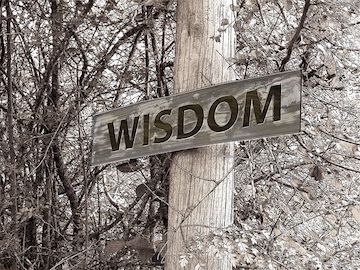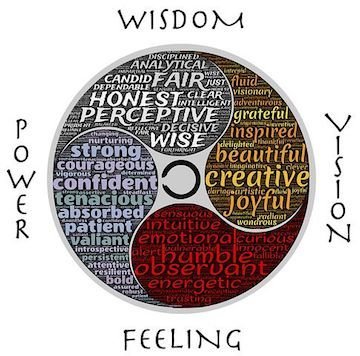The Buddhist 10 Fold Path
Right Speech

Right speech is the first of three parts that make up the virtue and moral discipline aggregate of buddhist training of the noble Eight-fold Path. Right speech is the antidote to wrong speech as explained in the Majjhima Nikaya, as well as recognizing that knowing what is wrong- and right speech is part of right view:

“Therein, monks, right view comes first. And how does right view come first? One understands wrong speech as wrong speech and right speech as right speech: this is one’s right view.” — MN III.73
“And what, monks, is wrong speech? False speech, malicious speech, harsh speech, and gossip: this is wrong speech.” — MN III.73
In the same way that right intention was explained as being two-fold, the teachings on right speech follow the same way of explaining the two types:

“And what, monks, is right speech? Right speech, I say, is two-fold: there is right speech that is affected by taints, partaking of merit, ripening in the acquisitions; and there is right speech that is noble, taintless, supra-mundane, a factor of the path.” — MN III.73
“And what, monks, is right speech that is affected by taints, partaking of merit, ripening in the acquisitions? Abstinence from false speech, abstinence from malicious speech, abstinence from harsh speech, abstinence from gossip: this is right speech that is affected by taints... ripening in the acquisitions.” — MN III.74
Whereas the mundane type of right speech is exercised towards the four types of wrong speech that are being abstained from, in case of the supra-mundane path, a single method of right speech works as the four-fold function by cutting off the tendencies of the four types of wrong speech:

“And what, monks, is right speech that is noble, taintless, supra-mundane, a factor of the path? The desisting from the four kinds of verbal misconduct, the abstaining, refraining, abstinence from them in one whose mind is noble, whose mind is taintless, who possesses the noble path and is developing the noble path: this is right speech that is noble... a factor of the path.” — MN III.74
To tie in how right view, right speech, right effort, and right mindfulness are connected, the teachings explain how these are supports of each other:

“One makes an effort to abandon wrong speech and to enter upon right speech: this is one’s right effort. Mindfully one abandons wrong speech, mindfully one enters upon and abides in right speech: this is one’s right mindfulness. Thus these three states run and circle around right speech, that is, right view, right effort, and right mindfulness.” — MN III.74
The noble Eight-fold Path as a whole is regarded as a Middle Way (majjhima patipada), where this middle avoids the two extreme practices of over-indulgence and self-mortification. Other extremes to be avoided are the doctrines of eternalism (sassata-vada), annihilationism (uccheda-vada), partial eternalism (ekaccasassata-vada), and intellectual evasiveness (amaravikkhepa). Craving for existence is meant by the eternalist view, and craving for mortification by the annihilationist view. The teachings are clear that the type of speech, especially concerning what to teach as being the Dhamma, is important:

“The Middle Way discovered by the Buddha avoids both extremes; giving vision, giving knowledge, it leads to peace, to direct knowledge, to enlightenment, to Nibbana. One should know what it is to extol and what it is to disparage, and knowing both, one should neither extol nor disparage but should teach only the Dhamma. One should know how to define pleasure, and knowing that, one should pursue pleasure within one-self. One should not utter covert speech, and one should not utter overt sharp speech. One should speak without hurry, not hurried.” — MN III.230
In explanations of right speech, it is often said that the virtuous person is “one who speaks what is beneficial (or ‘meaningful’), one who speaks on the Dhamma:

“Such a person, monks, is called one who speaks at the proper time, who speaks in accordance with fact, who speaks what is beneficial, who speaks Dhamma, who speaks discipline. And why is such a person called one who speaks at the proper time... who speaks discipline? This person does not inflict suffering upon another under a false pretext—by killing, imprisonment, confiscation, censure, or banishment— thinking: ‘I am powerful, I want power.’” — AN I.204
In the next post No. 4 of the path will be discussed: Right action.

The Nikayas are Buddhist books that form the earliest Buddhist canon of scriptures containing the teachings of the Buddha.
Today we’re going to be examining the Eight Fold Path, and even more so, the Ten Fold Path that is not as well known.
First of all, it really helps to have these books in digital form, so you can search for a particular word easily and be able to read how it is mentioned and in what context it is placed in the teachings of the Buddha.
The following English translations of the primary texts are available and used:
- The Connected Discourses of the Buddha: A Translation of the Samyutta Nikaya (SN)
- The Long Discourses of the Buddha: A Translation of the Digha Nikaya (DN)
- The Middle-Length Discourses of the Buddha: A Translation of the Majjhima Nikaya (MN)
- The Numerical Discourses of the Buddha: A Translation of the Anguttara Nikaya (AN)
The Eight-fold Path consists of:
A. The Wisdom aggregate of training
- Right view (samma-ditthi, but also samma-dassana)
- Right intention / thought (samma-sankappa)
B. The Virtue and Moral Discipline aggregate of training
- Right speech (samma-vaca)
- Right action (samma-kammanta)
- Right livelihood (samma-ajiva)
C. The Concentration aggregate of training
- Right effort (samma-vayama)
- Right mindfulness (samma-sati)
- Right concentration (samma-samadhi)
The Ten-fold Path consists of two additional ‘folds’:
- Right knowledge / wisdom (samma-nana)
- Right liberation / release (samma-vimutti)
- AN = Anguttara Nikaya,
- DN = Digha Nikaya,
- MN = Majjhima Nikaya,
- SN= Samyutta Nikaya); followed by book number in roman capitalized numerals and verse number (for example, AN I.30 = Anguttara Nikaya book 1 verse 30).
Note: Quotations follow the PTS (Pali Text Society) naming and numbering format:


 A link to My Blog
A link to My Blog
@reddust,
I wish and I hope you will continue this series of articles! It's very informative and well described! Thank you my dear friend!
I would love to know who were your teacher and how did you meet them
I was lucky, I looked in a phone book for a Buddhist teacher near me and found a Korean zen center in a nearby town in Oregon. I have never had a Western Buddhist teacher. I check their qualifications and training. From my experience traditional trained monks and lay people are the best teachers. I’ve had 2 lay teachers, SN Goenka a vipassana Theravada teacher from Burma who passed away several years ago and Namkhi Norbu who is a Vajrayana Dzogchen teacher from Tibet. I’ve met lots of teachers over the years and you have to vet Buddhist teachers carefully.
Teachers are called spiritual friends and must be of the highest quality.
https://www.dhamma.org/en-US/about/goenka
http://tsegyalgar.org/theteachings/namkhainorbu/
http://www.koreanbuddhism.net/bbs/board.php?bo_table=2030
http://www.viewonbuddhism.org/spiritual_teacher_guru.html
Thank you for the advice it looks like you had an interesting journey
it's worth reading @reddust 😃
i like the virtues and moral discipline aggregate of training.
The right speech, right action and right livelihood are like the components of the saying you are what you preach. This is the problem of most people.They lack these three virtues. We have to be careful in our speaking, actions and our living.😃
The virtues and meditation helped me save my life. The trauma I suffered as a child was tearing me apart and I didn’t know how to let it go, I learned how to let go and found a path that I will stay on for the rest of my life🌀
So happy for you then. 😊
I will complete with you the discussion of the buddhist religion about the Muslims' killing and annihilation by Buddhists in Burma
The most established principle among the Buddhist monks is the lack of initiative to kill oneself. It is possible not to resort to violence, which distinguishes the essence of Buddhist teachings from any other religion.
In this sense, the question arises as to why monks resort to the use of hate speech against Muslims, but to join groups of mobs in actions that result in dozens of deaths.
That is what happens in two countries separated by the Indian Ocean by about 1,000 miles, namely Burma and Sri Lanka. It is puzzling that these two countries are not threatened by Islamic militants, and Muslims in both countries are peaceful and represent a small minority
@klasanaj, the issues with Muslims and Buddhist in Burma is complicated and centuries old. There are powers that gain strength from causing fighting between cultures, it is a war divide and conquer tactic and that is what is happening all over the world right now. Look at the Han and Tibetans over in what is now land claimed by China but has been traditionally Tibetan. That's all I am going to say about this..
When murder occurs does it matter what religion one practices? People have been killing each other for many reasons since humans have been recording history. Do you want to compare Buddhist violence and Muslim violence within their communities? We will go down a dark hole I do not wish to travel.
Certainly this issue is old and the mixing of what is political with what is religious
What is positive in Buddhism, is its doctrine of ethics and reform of society, and alleviate the misery,
But the question is whether Buddhism is a religion or a philosophy; that is, a moral doctrine
I've been told it is both a religion and a moral doctrine. Within all religions there is a moral doctrine and philosophy but it is up to the humans to follow the codes of conduct and understand the philosophy and religious views.
But the Buddha's money to deny God, followed by the denial of worship; because worship is only in the presence of the idea of God, and resulted in "the transfer of Buddhists Buddha From teacher to pioneer, then to god, "and invented colors of prayers and supplications
It would be wise to refrain comparing religions regarding this kind of post my friend. I refrain from going on Muslim posts and promote Buddhism.
I did not have a great knowledge of the Boudia article I did in the past days and the dialogue that took place between us pushed me purely from the Boudia and I did not compare it with Islam, but when I was informed of them found little things intersect with Islam
These are questions that I have recorded and suggested to you that you have studied this
I may stop asking questions and queries in this regard
I get used to it
Okay, I understand, but our language issues are getting in the way. I do not understand your question.
After the Noble Eightfold Path can be
compared to cultivating the park, but
in one's Buddhism cultivates
his own wisdom. The mind is the ground
and the mind is the seed. The deeds
is the way a person takes care of a garden.
Our mistakes are weeds.
Plucking it is like weeding the garden.
Harvest is true and lasting happiness.
@reddust
I also see the Noble 8fold path as cultivating a garden. Weeding takes wisdom, I have to figure out what is a weed and what isn't...hahaha
all religions bring love instead of war
Great post. I have read the share twice. @reddust
Mevlana says:
You task is not to seek for love, but merely to seek and find all the barriers within yourself that you have built against it.”
When you change your view you change the world! Thank you @turkiscrew.
Yes this is always valid. Thanks again @reddust
Thanks for the enlightenment @reddust. I really enjoyed the article, I only just found out the truth to the "BUDDHIST 10 FOLD PATH" and boy was it inspiring.
I am glad you enjoyed the article. What is the truth of the 10 fold path and why did it inspire you?
The truth in taking the right path.. Knowing your right from left, knowing what to and what not to do.
What is Wisdom
Release; freedom from the fabrications and conventions of the mind. The suttas distinguish between two kinds of release. Discernment-release (paññā-vimutti) describes the mind of the arahant, which is free of the āsavas. Awareness-release (ceto-vimutti) is used to describe either the mundane suppression of the kilesas during the practice of jhāna and the four brahma-vihāras [see AN 6.13], or the supramundane state of concentration in the āsava-free mind of the arahant.
https://www.accesstoinsight.org/glossary.html#vimutti
Define kilesas :
Defilement — lobha (passion), dosa (aversion), and moha (delusion) in their various forms, which include such things as greed, malevolence, anger, rancor, hypocrisy, arrogance, envy, miserliness, dishonesty, boastfulness, obstinacy, violence, pride, conceit, intoxication, and complacency.
Yea thank you
It nice post thank you
Great job
I was thinking of write a topic about Power types and power source these info will be helpful